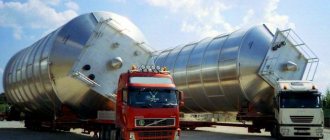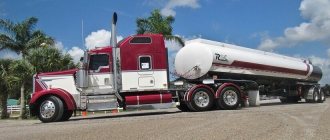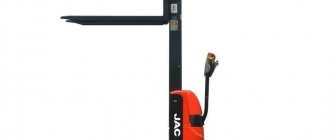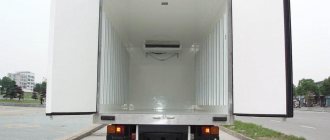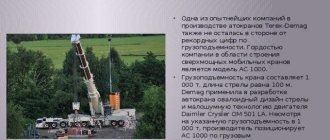REGULATORY DOCUMENTS
As you can see, only a small fraction of the aspects of transporting oversized goods are covered by the Road Traffic Rules. Basic regulation of the transportation of oversized cargo on the roads of the Russian Federation is carried out by Federal Law No. 257-FZ. In Chapter 5 of Article 31 you can find the following points:
- transportation of large and heavy cargo requires special permission;
- the procedure for obtaining a special permit is established by the government of the Russian Federation;
- Before transportation, it is necessary to coordinate the route with the owner of the roads;
- In case of damage, the amount of compensation is calculated by the owner of the road.
Based on the rights specified in the above-mentioned normative act, the “Rules for the carriage of goods by road” were drawn up. In this document you can find instructions regarding the procedure for organizing transportation, ensuring the safety of vehicles and containers, if necessary, conditions of transportation and provision of vehicles for transportation.
RELATED ORDERS AND RESOLUTIONS
In order to be guaranteed to protect yourself from problems when filling out an application for a special permit and directly when transporting oversized cargo, we recommend that you familiarize yourself with the following orders:
- No. 107: represents regulations for government agencies for issuing permits;
- No. 258: regulates the rules for issuing permits;
- No. 7: establishes rules to ensure safety when transporting oversized items.
Resolutions:
- No. 125: procedure for weight and dimensional control;
- No. 934 + No. 12: procedure for compensation for damage caused to the road;
- No. 125: rules for passing weight control;
- No. 211: establishes the rules for introducing a ban on cargo transportation.
Fines and punishments
To familiarize yourself with the amount of penalties imposed for violations of the rules for the transportation of oversized cargo, read Article 12.21.1 of the Code of Administrative Offenses of the Russian Federation. There you will find out exactly who should be punished for violations. For example, for not having a special permit, a driver can receive a fine of 2 thousand rubles, but, even worse, he can lose his driver’s license for up to six months.
Rules for transporting goods on the roof of a car
- stick out from the front and sides of the car,
- obstruct the view,
- disrupt the center of gravity and stability of the machine (that is, the load must be secured as securely as possible),
- block lights and identification marks (even with your hands),
- pollute the environment, generate dust and leave marks on the road surface.
Dimensions
These rules also work under other conditions. So, for example, if the car, together with the installed cargo, does not exceed a height of 4 m from the road surface and no more than 2 m from the rear, then the “oversized cargo” plate and other identification marks will not be required. If the dimensions exceed the specified values, then a special permit from the traffic police will be required.
Transportation of oversized cargo across the territory of the Russian Federation is regulated by Chapter No. 23 of the Road Traffic Rules, as well as a number of legislative acts and regulations at the federal level. They indicate a list of requirements for organizing the process of transporting massive and oversized cargo. Among these norms:
WHAT CARGO IS CONSIDERED OVERSIZED?
The cargo is considered oversized if its weight and/or size exceeds the value established by the traffic regulations of a particular country as acceptable during transportation. According to the traffic rules of the Russian Federation, oversized cargo is considered to be the following:
SDA ABOUT TRANSPORTATION
Paragraph 23.5 of the traffic rules states that vehicles transporting such cargo must be marked with the “Large cargo” sign. Additionally, in the dark (remember that this is considered the time from evening twilight to the beginning of twilight in the morning) and in conditions of poor visibility, a reflective element or a white light should be installed in the bow of the car, and a reflective element or a light source of sufficient power in the rear part Red. This is quite enough for driving on public roads.
SPECIAL REQUIREMENTS
Transportation of explosive, chemical or other dangerous goods, long objects or heavy loads is regulated by special standards established by the relevant government authorities. Special rules should be followed when driving a vehicle (with or without cargo) if:
Heavyweights
Also, special permission from the traffic police is required when transporting heavy cargo. What matters is the total weight of the vehicle and the object being transported. Specific values in different countries may differ, which should be taken into account when intending to cross the border. The definition of “heavy” in the Russian Federation includes:
- two-axle vehicles weighing more than 18 tons;
- three-axle vehicles weighing more than 25 tons;
- four-axle vehicles weighing more than 32 tons;
- road trains with 3 axles and weighing more than 28 tons;
- four-axle road trains weighing more than 36 tons;
- road trains with 5 and weighing more than 40 tons;
- road trains with 6 axles or more, weighing more than 44 tons.
Also, do not forget about the strict requirements for load distribution along the axles. Not only the distance between closely spaced axles matters, but also the standard loads of roads. When designing, constructing and reconstructing a roadway, the permissible axial load is set, for example, 6, 10 or 11.5 tons. That is why transportation can take place not along the shortest route, but with a choice of roads with a suitable load class.
Signs
Sign used to indicate oversized cargo:
Sign “Long-length road train” Long vehicle.
When transporting dangerous goods, the vehicle must be marked with the following sign:
COVER VEHICLE
Previously, if the length of a vehicle loaded with oversized cargo was more than 24 m, but less than 30 m, and the width was more than 3.5 m, but less than 4 m, then the appropriate conditions for transportation could be created by the transport company without the participation of representatives of the traffic police. But since 2014, when transporting heavy and oversized cargo, it is necessary to use a cover vehicle to ensure safety. Requirements for an accompanying vehicle:
- the presence of a yellow-orange stripe;
- presence of yellow and orange flashing lights;
- A reflective or illuminated sign must be installed, on which there will be an inscription warning about the characteristics of the cargo (for example, “Large length”).
TRAVEL ABROAD AND INTERREGIONAL TRANSPORTATION
If you intend to cross the border, please note that a car without a special international permit will be detained.
When passing a route through two or more territorial units of the upper level of the Russian Federation, an interregional permit must be obtained. As in the case of an international special permit, you can apply for it through the State Services website. You can fill out an application during a personal visit at the offices of the Road Management Administration of the Russian Federation or at its subsidiary branches.
HOW TO GET PERMISSION
Obtaining permission to transport oversized cargo is regulated by the so-called Order 258. It is in this document that you can find out:
- admission parameters and conditions for refusal to submit an application;
- a complete description of the procedure for drawing up and submitting an application;
- what the document should look like and what information should be included in it;
- subtleties when coordinating the transportation of heavy objects;
- established deadlines for obtaining permission;
- procedure for issuing a special permit or obtaining a refusal.
Basic rules for transporting oversized cargo
The maximum permissible height of the transported cargo from the ground or the permitted width of the transported cargo on the trailer, as well as the weight of the product, are not the only criteria for high-quality and safe transportation. When accepting orders, the Gazelkin cargo taxi takes into account a large number of factors that allow it to perform the work as efficiently and effectively as possible.
Qualified employees know exactly how much length can be transported according to the rules, how to stack and secure various objects in the body, and under what parameters a permit will be required. To ensure that the customer does not have problems, the following requirements are met:
- Heavier objects are placed in the lower part of the body. This arrangement makes it possible to achieve greater stability of the vehicle and, accordingly, safety when driving.
- Products are placed evenly in the body, and the gaps between items are filled with soft pads, foam and other similar materials.
- All products in the body are carefully secured, and during movement, deviations from standard places are monitored. In case of any suspicions, the products are reattached.
- To inform other road users, a “Large Load” sign is posted on the outermost protruding part. Additional installation of reflective elements is possible.
- When transporting special cargo, an appropriate permit is issued.
Vehicles with an external and internal turning radius of no more than 12.5 and 5.3 meters, respectively, are allowed to be used.
In accordance with the accepted rules, the cargo is suitable for large-sized cargo if the total weight of the loaded equipment does not exceed 38 tons, and also if its length and width do not exceed 24 and 2.55 meters, respectively, and its height is 2.5 meters. In case of any deviation, the products are classified as oversized and require a special permit.
Contacting the Gazelkin cargo taxi is an opportunity to quickly and inexpensively resolve the issue of transporting any cargo, regardless of the transportation distance.
The presence of technically trained and serviceable machines of various lifting capacities, as well as professional employees, guarantees the impeccable execution of the application. The car will arrive at exactly the specified time at the desired address, and all related issues can be discussed with the manager, available by phone or email. sale of backhoe loaders
PROHIBITION ON TRANSPORTATION
Let's look at the cases in which transportation of oversized items is prohibited:
- the load interferes with driving;
- with a load the car becomes unstable. To prevent a truck from tipping over, it is imperative to take into account seasonal characteristics and the risk of exposure to heavy winds;
- due to the size of the object, the driver’s visibility is limited, as a result of which he cannot adequately assess the road situation;
- the cargo covers lighting fixtures, reflectors, identification marks, and state license plates;
- During transportation, environmental pollution occurs.
TRANSPORTATION RULES
A vehicle with oversized cargo moving on the roads should not accelerate more than 60 km/h. In this case, bridges should be crossed at a speed of no more than 15 km/h. Particular attention should be paid to the technical condition of the vehicle. The trailer must be equipped not only with a working parking brake, but also with a special device that guarantees stopping the trailer if the air lines of the pneumatic braking system coming from the tractor rupture. The load must be securely fastened, and the integrity of the fastening must be periodically checked.
The rules for the transportation of oversized cargo are covered in Section 23 “Transportation of Cargo” of the Road Traffic Regulations and, in particular, 23.4, which prescribes the designation of oversized cargo with special signs. In the dark, as well as in case of insufficient visibility (read: snowfall, fog, rain), use reflectors or flashlights: white in front, red in back.
By oversized cargo, traffic regulations mean one that protrudes beyond the front/rear dimensions of the vehicle by more than a meter, or on the side by more than 0.4 meters from the side lights.
As stated in the traffic rules, the transportation of oversized cargo (including heavy cargo) is separately regulated by requirements, standards and rules. However, you need to know that the leading role still belongs to traffic rules. Therefore, if a controversial situation suddenly arises, you can go to court, which, as a rule, makes a decision based specifically on the points of the traffic rules, and not on some departmental rules.
After the new Rules for the transportation of goods by road have come into force, the well-known Instruction continues to apply, prescribing the rules for the transportation of heavy and large-sized cargo by road on the roads of the Russian Federation, but only to the extent that does not contradict the new Rules. In any case, the loads on each axle should never exceed those permitted by the manufacturer, and it is necessary to take into account the weight of the semi-trailer, which also cannot be more than the maximum permissible values.
Also, every driver must know that transporting large cargo is possible only under conditions when the cargo:
- does not interfere with the driver's view. And the driver must see both the entire road situation ahead and behind with the help of rear-view mirrors;
- does not interfere with control and does not affect the stability of the vehicle;
- does not block external reflectors and lighting devices, license plates and other identification marks for other traffic participants, and does not create obstacles to the perception of hand signals.
- does not pollute the environment, does not create noise, dust, etc.
There are also traffic features in terms of speed limits. Oversized cargo is required by traffic regulations to be transported at a speed of no higher than 60 km/h on roads, and 15 km/h when driving on bridges.
In addition, the driver is prohibited from deviating from the prescribed route, agreed upon with special authorities. If any of the conditions stipulated by the traffic rules for the transportation of oversized cargo is violated, the driver must correct the violation or stop driving. If this is not done, then a fine or even deprivation of rights will follow, according to Article 12.21 of the Code of Administrative Offenses of the Russian Federation.
For example, for transporting heavy or large cargo without a special permit (if one is required), as well as in case of deviation from the route specified in the special permit, the driver can be fined in the amount of 2,000 rubles or more, or deprived of his driver’s license for up to 6 months , and also detain the vehicle. For officials and legal entities, fines are much higher - up to 20,000 and even up to 500,000 rubles, respectively.
When transporting cargo exceeding the dimensions specified in the special permit by more than 10 cm, the driver may be fined up to 2,000 rubles or deprived of his license for up to 4 months. An official can be fined up to 15,000 rubles, a legal entity can be fined up to 400,000 rubles. And also - to detain the vehicle.
If the maximum weight or axle load exceeds those specified in the special permit, drivers, officials and legal entities will also face fines, as in the previous situation. But there is no provision for deprivation of rights and delay of the vehicle.
Transportation itself represents the movement of an object from one place to another. But sometimes you have to transport cargo of various parameters, some of which do not fit into a certain framework.
What to do in this case, and is there such information in the traffic rules for transportation of oversized cargo?
By default, it is believed that oversized cargo is an object whose parameters are larger than the vehicle itself, and accordingly it violates transportation requirements and increases the possibility of accidents.
That is why, when transporting objects of inappropriate size, they must be marked to ensure visibility over a considerable distance for other road users. This is done so that vehicle drivers have time to react and take measures to overcome obstacles.
Oversized cargo is divided into two subtypes:
- the cargo is large, this is the case when the object has larger parameters than the vehicle carrying it, and can protrude onto the roadway;
- the cargo is heavy, that is, its weight exceeds the maximum permissible that the vehicle can transport.
For freight transportation, an item exceeding the following indicators is considered oversized:
- its height will be 2.5 m or more;
- the weight of such an object is more than 38 tons;
- length exceeds 24 meters;
- width parameters more than 2.5 m.
Oversized cargo dimensions, traffic regulations requirements 2020
To prevent a truck from tipping over, it is imperative to take into account seasonal characteristics and the risk of exposure to heavy winds;
- During transportation, environmental pollution occurs.
- the cargo covers lighting fixtures, reflectors, identification marks, and state license plates;
- due to the size of the object, the driver’s visibility is limited, as a result of which he cannot adequately assess the road situation;
Transportation rules A vehicle with oversized cargo moving on the roads should not accelerate more than 60 km/h.
In this case, bridges should be crossed at a speed of no more than 15 km/h.
Particular attention should be paid to the technical condition of the vehicle.
Today, the need to transport large loads has increased greatly.
For this purpose, vehicles with increased carrying capacity requirements are used. Oversized cargo extends beyond the dimensions of the vehicle and exceeds traffic regulations.
Rules for the transportation of oversized goods
In order to transport cargo exceeding the permissible dimensions, a number of requirements must be met:
- the item being transported must not block or impair the driver’s visibility;
- should not affect the vehicle, worsening its stability;
- cannot interfere with the visibility of signals given to the driver, nor hide any identification marks and devices of the vehicle;
- should not have a negative impact on the road and the environment as a whole.
It is also worth remembering that you must have a special permit for this type of transportation.
If any of these conditions are violated, it is urgently necessary to stop the vehicle and eliminate the obstacle. Otherwise, the motorist faces a fine for oversized cargo.
Maximum cargo height for road transport
Escort services are paid separately from transportation services (of course, if it is not carried out using your own vehicle).
Attention
You should be careful when hiring private carriers, especially when transporting large items.
Important
Many of them say that they have friends in the traffic police and are ready to transport large cargo without permits.
In this case, you may be responsible for any damage that may occur during transportation.
Info
Tips Before transporting, the entire process must be carefully thought out in accordance with the characteristics of the cargo.
This includes: hiring carriers (if you don’t have your own vehicle) and traffic police officers (if necessary), measuring dimensions, planning a route and obtaining permits.
What are the penalties for transporting oversized cargo?
If possible transportation conditions are violated, a penalty such as a fine for oversize is provided.
Who will be subject to penalties in this case? If a company sent cargo on a flight with parameters exceeding the permissible ones, should the driver be held responsible for this?
If you refer to clause 1 of Article 12.12.1 of the Administrative Code, you can understand all the nuances and find the culprits:
- The driver will be responsible for the fact that he accepted the cargo and gave his consent to its transportation. He faces a fine of 2,500 rubles. Also, according to this article, he may lose his driver's license for a period of up to 6 months.
- In addition, the official who was issued the transportation permit will be punished; the amount of penalties will be up to 20,000 rubles.
- And the company, that is, a legal entity, will have to pay a fine of up to 500 thousand rubles.
How to choose a route for transporting oversized goods?
If you want to transport oversized cargo, you must carefully consider the route of the vehicle, which will move on public roads. Because of this, when choosing a path you need to consider:
- quality of road surface;
- road width;
- the presence of bridges, crossings and other obstacles;
- traffic congestion;
- permitted speed.
Experts recommend initially looking for several possible routes at once, after which each of them must be studied separately and only after that choose the most optimal one, taking into account the individual pros and cons of each.
If professional logisticians are involved in solving the problem of choosing a route, they will be guided by a single principle: the best route is the fastest, however, oversized dimensions create many additional problems, for example, the impossibility of crossing bridges and railway crossings, as well as the need to take into account weather conditions in the regions, etc.
When planning routes, you need to take into account the need to travel through cities. If it is impossible to avoid driving along city streets, then the route should be designed in such a way that the car ends up on these roads at night, so that an oversized car will create fewer problems for other road users.
Sometimes, in order for an oversized vehicle to travel through city streets, it requires additional escort, as well as preliminary approval from traffic police representatives.
It would also be useful to take into account when planning your route:
- technical characteristics of the car;
- parameters of the cargo itself;
- organizations with which you will have to coordinate transportation;
- responsibilities of the parties to the transaction.
The transport company transmits data about the future route and all necessary accompanying documents to road organizations in order to exclude the possibility of unsuitable sections on the route, for example, with unsuitable road surfaces or obstacles in the form of electrical wires, bridges, etc.
How to organize transportation?
There are times when there is a very great need for the delivery of large objects by road transport. In this case, it is better to think through all the nuances in advance and take care of obtaining the appropriate permit from the department of the Ministry of Transport. To avoid possible problems with police officers during its transportation.
The following data will be required:
- all measured parameters of the transported item,
- itinerary,
- all available quality certificates, which should contain a description of the equipment and all its characteristics.
This issue will be considered, taking into account the existing communications along the route, which could complicate transportation. It is possible to propose another route, where there will be no, for example, low bridges or other objects impeding traffic. The option of transporting equipment by another type of transport may also be offered.
If there is a potential danger to other road users, accompanying patrol cars may be assigned. They will be able to warn other drivers about a possible threat, thanks to the use of a light beacon.
It is also worth remembering that there are special identification marks on the equipment that indicate “large cargo”.
What is oversized?
Oversized cargo refers to all types of machinery, equipment and building structures, the weight and dimensions of which exceed permissible standards or are close to them. There are three main types in this classification:
- Large cargo.
- Heavy loads.
- Large and heavy loads at the same time.
| Large cargo parameter | Oversized cargo sign |
| Maximum dimensions | 2000x400x255cm (LxWxH) |
| Maximum length | 20 meters total length of the road train or protrudes 2 meters beyond its limits |
| Weight Limit | up to 44 tons total weight of the road train (6 axles) |
Large equipment and machines include those products and units whose dimensions exceed 255 cm in width, 400 cm in height and 20 meters in length. This segment also includes long loads that exceed the dimensions of the vehicle in front, behind or on both sides by more than 200 cm.
Heavy cargo includes equipment and machinery, the weight of which on one individual axle of a freight transport or on all axles at the same time exceeds technological standards. For example, for cars, equipment is considered heavy if its weight together with the vehicle exceeds 44 tons (provided the load is distributed over 6 axles). More details about heavy transport here.
The third option is a load whose dimensions exceed the established dimensional standards, and the mass is approaching critical in relation to the load on each axle of the vehicle or on all axles at the same time.
In which industries is large-scale transportation in demand?
Most often, transportation of large cargo is required in the following industries:
- Municipal, industrial, road construction.
- Construction of infrastructure facilities.
- Energy.
- Industrial production.
- Agricultural objects.
- Transportation of vehicles.
- Mining industry, etc.
For example, all kinds of special equipment, gantry and other cranes, individual reinforced concrete and metal structures are transported for construction. Infrastructure facilities also require delivery of finished structures to the installation site - parts of bridge crossings, towers, towers, etc. For the energy sector, transport and logistics companies deliver individual units and other heavy equipment manufactured in the workshops of manufacturing enterprises.
The mining industry occupies a special place in the segment of transportation of large cargo. For this purpose, carriers deliver large quantities of drilling rigs and special equipment, and transport pipe products of various lengths and diameters. Also, at mining sites, modular contractions are widely used to ensure the life and recreation of specialists.
As for industrial enterprises, they are interested in the delivery of large-sized equipment - machine tools, rolling lines and conveyors, individual blocks and units of large mass and size. In addition, the products of these industries are delivered in large quantities - sheet metal, metal profiles, etc.
Agriculture is no less interested in transporting non-standard cargo than industry. Professional carriers deliver all kinds of equipment to the place of agricultural work - tractors, combines, as well as various equipment for processing products.
In addition to equipment, special equipment, large quantities of rental products, professional transport companies transport all kinds of marine vehicles. Among them are yachts and other vessels of small displacement.
Stopped by a traffic inspector, what do you need to know?
If the vehicle was stopped and penalties were imposed for incorrect transportation of oversized items, then the administrative violation report must contain all the facts that are evidence of the violation. In addition, it must contain data about the device with which the control measurements were made. And the device itself must undergo appropriate testing.
What is used for measurement?
In most cases, a conventional telescopic ruler is used. And here, it is worth keeping in mind that this device does not have any certificates and has not passed the appropriate tests.
That is, the statement that it can produce an error is absolutely justified.
In addition, during the measurement process, witnesses are most often not involved, who are subsequently able to confirm that the measurements were carried out with this particular ruler. Traffic police officers often overlook such moments.
In addition to these nuances, it is necessary to remember that there must be a special register of devices that traffic police officers use in their work. And this measuring device, that is, the notorious ruler, should be included in his list. But in practice, such documents are usually absent.
Often during transportation it is necessary to transport various oversized cargo. There is no clear definition in the traffic rules for this.
It is generally accepted that a load is oversized if it does not meet the requirements and exceeds the size of the vehicle itself, as a result of which the risk of accidents increases. Therefore, oversized vehicles must be identified in such a way that other road users can notice them from a great distance and take measures to ensure safety.
There are two main types of this type of cargo:
- large - exceeds the size of the vehicle and may block part of the roadway;
- heavy - its weight is more than the maximum permissible weight that this machine can carry.
When it comes to freight transportation, oversized cargo exceeds the following parameters:
- its height is more than 2.5 m;
- weighs from 38 tons;
- length starts from 24 m;
- width - from 2.55 m.
What is the penalty for non-compliance?
It should also be recalled that the administrative code provides for punishment for improperly organizing the transportation of oversized items without the appropriate permission.
- In particular, Article 12.12.1 Part 1 of the Code of Administrative Offenses states that the driver will have to pay a fine of 2,500 rubles.
- The official who authorized such transportation will be required to pay 15-20 thousand rubles.
- And for a legal entity, liability is imposed in the form of 400-500 thousand rubles.
Under the same article, a driver can be deprived of his driver’s license for up to six months.
Based on all these factors, the driver and the responsible person may receive not only a fine for oversized cargo, but also lose their license. Therefore, it is necessary to study and strictly adhere to the rules for transporting oversized items, which are described in the traffic rules.
Are there any restrictions on cargo transportation?
According to the current rules, oversized cargo is divided into two types:
- heavy - exceeding the maximum permitted weight for transportation on a specific type of transport;
- large-sized – exceeding the dimensions of the vehicle on which they are transported. For this reason, such loads can block the roadway, which creates a danger for other road users, including pedestrians.
Thus, a lot depends on what type of transport the item is transported by. If oversized cargo meets the requirements of the rules, then it can be transported without obtaining a special permit. If such a document is missing, and one of the parameters exceeds the permissible values, the driver will be fined. In addition, a special reflective indicator must be installed on the vehicle transporting the CTG.
So, a fine for oversized length on a truck is provided if this parameter exceeds 2000 cm. As for weight, it should not be more than 38 tons. If we are talking about the width of an object, then the maximum permissible value is 255 cm. This is the norm established by law. When an oversized load exceeds this width, the driver will be fined.
In addition, the rules state that a KGT should be considered as such if it protrudes 40 cm or more on the sides of the car and one meter in the back and front or exceeds the permissible weight for transportation on a specific type of vehicle. It is worth noting that when transporting an oversized item, its height must also be taken into account. This parameter has a limit of 400 cm. Exceeding the height dimensions is also subject to a fine.
The driver of the truck should also remember that he will be fined for driving under the sign “Traffic traffic is prohibited.” In cities, the movement of such vehicles is limited in order to prevent traffic jams, asphalt wear, reduce noise levels, and reduce emissions into the environment.
Large cargo sign
First of all, the vehicle is marked with a special sign “Large cargo”. It is a metal plate with diagonal white and red lines on it. The size of the shield is 40x40 cm. It is also possible to use stickers of a similar size.
The surface of the sign must be reflective so that it is visible both during the day and at night.
In addition to this plate, any truck must be marked with the following signs:
- road train;
- large size;
- Long Vehicle.
This sign must be installed on those parts of the load that protrude above the roadway. Reflectors are also used. They should be white in the front and red or orange in the back.
Why is it difficult to transport oversized cargo?
Transportation of oversized cargo is a special type of cargo transportation, so before turning to a specialized company for help, you need to understand what is needed to transport oversized cargo. To carry out such a complex delivery it is necessary:
- choose the optimal vehicle capable of transportation;
- take into account the specifics of the regions through which the car will travel;
- choose the most convenient transport route to save time and money;
- calculate the duration of transportation;
- take into account possible difficulties that may arise during transportation;
- calculate the cost of delivery;
- prepare the necessary documents.
Without first resolving all of these issues, you should not begin transportation, since rash actions can cause many difficulties, additional and unjustified financial costs.
Oversized cargo - transportation by passenger transport
You can often see how oversized cargo protruding above the roadway is transported in passenger cars, similar to trucks. Drivers of passenger cars are also subject to liability for violating transportation rules, so they should be considered.
The following cargo is considered oversized:
- protrudes more than one meter from the back or front;
- from the side - 40 or more centimeters.
If you are dealing with this type of transportation, then you must use the above plate (sign) and attach it directly to the protruding parts of the oversized cargo. At night, in addition to the sign for oversized cargo, use reflectors - white in front, red in back.
The load must be placed in such a way that it does not block the driver’s view, there is no risk of it slipping, and does not cause damage to the road surface or auxiliary structures.
Please note that if the load protrudes from the rear or front by more than 2 meters, and the total width exceeds 2.55 meters, then its transportation in passenger vehicles without special permission is prohibited. If you are stopped by an inspector, there is a high probability that a corresponding report will be issued and you will be deprived of your rights for up to six months.
Maximum height of cargo transported on a truck, traffic regulations
Important
If the above violations are recorded by technical means of photography and video recording, the owner of the trucking company may be fined 150 thousand rubles. If the dimensions of the vehicle exceed the established dimensions by 0.1 m (but not more than 0.2 m), as well as if its weight or axle load exceeds the permissible value by 10% (but not more than 20%) without appropriate permission, the following provisions are provided: fines: for drivers - 3-4 thousand rubles, for officials - 25-30 thousand rubles, for legal entities - 250-300 thousand rubles. In case of photo or video recording, the owner of the vehicle will be fined 300 thousand.
rubles
If the dimensions of the vehicle are exceeded by 20 to 50 cm, as well as if the weight or axle load exceeds the permissible by 20-50% without special permission, the following fines are imposed. Drivers – 5-10 thousand.
Large cargo”, install white lights and reflectors in the front and red ones in the rear.
If the transported objects protrude from the rear of the truck by more than 2 m, and the height of the object exceeds 4 m, special rules established by the Government and the Ministry of Transport apply.
Responsibility for violation of requirements
The driver driving the vehicle bears full responsibility for compliance with the rules for transporting oversized cargo. In case of non-compliance, he must immediately take measures to eliminate them, and if possible, stop driving the vehicle. In addition, the transport owner must constantly monitor the condition of the cargo to avoid it falling or being damaged. The object must not cause harm either to the car itself or to other road users.
For improper delivery arrangements, the driver of the vehicle may be fined. Thus, when transporting a large object without a special permit, the motorist must pay from 2 to 2.5 thousand rubles
, and if the weight of the cargo exceeds -
from 1.5 to 2 thousand rubles
. As for transporting objects that exceed their size, in this case the driver may face deprivation of his license for a period of 2 to 4 months. In addition to it, officials and legal entities may be held administratively liable.
In a passenger car, cargo can be transported in the passenger compartment, in the trunk, or on the trunk. But subject to certain requirements.
1. Carrying cargo is prohibited if it restricts the driver’s visibility.
If the cargo being transported obscures the rear view, this is only permissible if the vehicle is equipped with exterior rear-view mirrors on both sides.
However, if the cargo blocks the view to the right or left, or, God forbid, from the front, then the transportation of such cargo is strictly prohibited.
2. Carrying cargo is prohibited if it makes it difficult to drive a vehicle.
To place the cargo, the driver pushed his seat forward.
Now it will be difficult to drive a car. This means that such cargo transportation is prohibited.
3. Carriage of cargo is prohibited if it violates the stability of the vehicle.
The car is sensitive to a shift in the center of gravity. If the load is heavy, then with this arrangement the car will inevitably be pulled to the left.
And it’s better not to talk about turns or reversals.
This is how to arrange the load correctly. And it does not contradict the requirements of the Rules.
4. Transportation of cargo is prohibited if it covers external lighting devices, as well as registration or identification marks.
I can’t imagine a load that covers the headlights, much less the front license plates. That is, you can imagine it - let’s say a load is on the trunk and hangs down to the ground. But in this case, the load necessarily blocks the driver’s view. And this alone is enough to make such cargo transportation impossible.
But if the load covers the rear
numbers and a block of
rear
parking lights, then this does not interfere with movement.
But the Rules prohibit such cargo transportation.
5. Carrying cargo is prohibited if it interferes with the perception of hand signals.
The rules take into account the situation when the turn signals or brake lights fail along the way, and you need to somehow get to your destination. In this case, as you already know, the driver is required to give hand signals. So, if the cargo being transported prevents other drivers from seeing these signals, further movement is prohibited.
6. Transportation of cargo is prohibited if it is noisy, dusty or pollutes the environment.
You can imagine how cargo can generate dust or pollute the environment. But, by God, I don’t know how he can make noise.
7. If the load extends beyond the dimensions of the vehicle.
less than 1 meter
,
If the load protrudes beyond the dimensions of the vehicle in front or behind by more than 1 meter
,
then...
...during daylight hours, the cargo must be marked both front and rear with identification signs “Large cargo”...
... and in the dark or in conditions of insufficient visibility, in addition to the sign on the front, the load must be marked with a lantern or a white reflector, and at the rear - with a lantern or a red reflector.
If the rear protrusion is more than 2
meters, the transportation of such cargo must be coordinated with the traffic police department on whose territory the transportation route begins. That is, for you and me, this simply means that the transportation of such cargo is prohibited.
Interestingly, the Rules did not limit the protrusion of the load from the front in any way. And, therefore, here the driver needs to use common sense.
8. If the load protrudes beyond the dimensions of the vehicle from the side.
As for the protrusion of the load from the side, here the Rules set drivers a difficult task. It is necessary to measure the distance not from the extreme point of the car's dimensions, but from the edge of the side light.
If the protrusion of the load from the edge of the side light does not exceed 0.4 meters
,
and the total width of the load
does not exceed 2.55 meters ,
there is no need to worry about anything. You can safely transport such cargo.
If the protrusion of the cargo from the edge of the side light exceeds 0.4 meters, but the width of the cargo is not more than 2.55 meters, such cargo is permitted to be transported. It just needs to be marked.
During daylight hours, such cargo must be marked on both sides with identification signs “Large cargo.”
In the dark and in conditions of insufficient visibility, the cargo, in addition to signs, must be marked in front with white lights or reflectors, and at the rear with red lights or reflectors.
If the width of the cargo exceeds 2.55 meters (regardless of how much it protrudes from the side), consider that the carriage of such cargo is prohibited.
